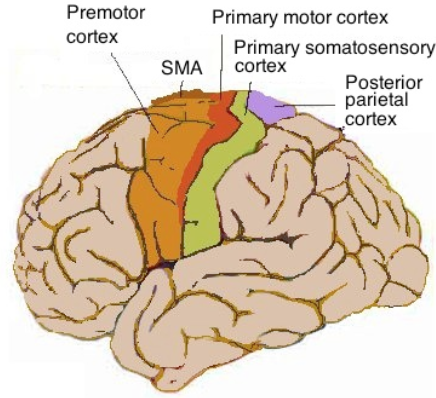The human cortex handles higher abilities like language that set us apart from other species. While the cerebellum packs 80% of the brain’s neurons into 10% of its mass, the cortex needs 80% of the brain’s mass to support 20% of its neurons, because they are larger and have more support cells. It is a folded sheet, 2-5mm thick, with six layers, while the midbrain hippocampus only has three layers. It was the last part of the brain to evolve and is the last to mature in children. If other centers ran the feedback loop before it, how can it take control? The answer, it seems, is with difficulty.
Piaget concluded that the human intellect develops in four distinct stages:
1. Sensorimotor (0 to 2): Babies and toddlers think in sensorimotor terms.
2. Preoperational (2 to 7): Children begin to think symbolically and learn language.
3. Concrete operations (7 to 11): Children think logically about concrete events.
4. Formal operations (12+): Abstract thought emerges.
The cortex can’t act independently until over 12 years old and it continues to mature into the mid-twenties, as the ability to think increases.
In the sensorimotor stage (0 to 2), the moving center controls activities like reaching so it also tries to speak. Hence, language begins as babbling, as babies form sounds to match the speech that they hear in the first year. Babble can sound just like speech, although no words are known yet. The moving center tries to talk as it learns to walk – by just doing it. Before an infant says its first word, at about one year, it knows all the phonemes needed for speech, including intonations. The midbrain isn’t mature enough to lay down memories until two or later, so before that we have childhood amnesia, a period we can’t remember because the midbrain couldn’t lay down long-term memories. The same occurs in animals for the same reason (Feigley & Spear, 1970).
In the preoperational stage (2 to 7), the emotional center increases control of behavior, to make us emotional beings who think everyone sees the world as we do. A five-year-old asked what is in a chocolate box will say “chocolates” until shown it contains pencils. If then asked what another child will think is in the box, they say pencils not chocolates. They can’t imagine how others see the world yet and so have no empathy.
While the emotional center is in charge, the developing intellect produces egocentric speech, where the child keeps up a running commentary on what they do, even when alone. At first they comment after an action, so a four-year-old child may stroke a teddy bear then say “Good boy”, but at five the same child says “Good boy” as they stroke it, and at six they say it first then stroke it. It is as if a part of the brain is first observing what is happening and making after-the-fact comments, then making current comments, and finally predicting what will happen. Egocentric speech is the child’s growing intellect expressing itself out-loud to the rest:
“One area of the brain and mind may initiate a behavior, which is witnessed or experienced by other (disconnected) brain areas, only as it occurs outside the brain and body.” (Joseph, 2017a) p442.

In the concrete operations stage (7 to 11), the intellect learns to apply thought to concrete things. A child under 7 may think that spacing out checkers in a line increases their number, but by 9 they know that number is still conserved (Figure 6.30). Yet they still struggle to reason abstractly.
Not until the formal operations stage at about twelve does the intellect manage to think abstract ideas. Prior to this, we learn in a formatory way, by memory associations not logic. Children under 12 can rote learn dates for a history exam but struggle with abstract mathematics. As the intellect matures, it can change from backward thinking to forward thinking, from finding reasons to justify conclusions already held to forming new conclusions by analyzing agreed facts.
Backward thinking is people cherry-picking the Internet for facts to confirm preconceptions while forward thinking is the scientific method. Formal operations let children think scientifically, but it still takes another decade to do it routinely. Western science began when Socrates started to think forwards but two thousand years later, we still struggle to follow his example because thought hurts! For example:
Bob rides his bicycle to pick up his motorbike from the repair shop at 10 mph. How fast must he ride his motorbike back to average 20 mph for the whole trip?
Emotional thinking suggests 30mph but using the intellect shows that is impossible.

Does the cortex control the feedback loop as it matures? It has the nerve links to do so as the sensorimotor cortex (Figure 6.31) maps to body muscles based on importance (Figure 6.32)
A voluntary act, like raising the hand, occurs when the frontal lobe directs the supplementary motor area (SMA) to prepare the movement and tell the motor cortex to do it. The SMA activates even at the thought of moving, long before muscles move (Nachev et al., 2008), suggesting to some that:
“… the “will” to move begins in the SMA and medial frontal lobes and exerts executive control over the secondary, primary and subcortical motor areas which then perform these “willed” actions.” (Joseph, 2017b) p151
The author concludes that: “The frontal lobes serve as the ‘Senior Executive’ of the brain …” (Joseph, 2017b) p138, but how can two frontal lobes have one will? The brutal fact of neural science is that multiple systems drive bodily actions:
“Figuratively speaking, the skeletomotor output system is akin to a single steering wheel that is controlled by multiple drivers …” (Morsella et al., 2016) p6.

The frontal lobes can initiate muscle movement but so can other brain centers. The cortex has voluntary muscle control but its ability to coordinate a successful golf swing is close to zero. It also struggles with emotional urges, as when we plan to eat less by dieting, we can deny one cake but to always do so takes more than intellectual “will”. Like the triumvirate of Rome, at least two of the three control centers must agree for a long-term plan to work. The ideal for our brain isn’t some sort of neural dictatorship but for its centers to share control in a balanced way.